If we are talking about Japanese sake, also called Nihonshu, we often hear about rice polishing grade. But this sake rice polishing grade, what is it really? To be honest, on a label of a bottle of sake, it is probably the most confusing component. But a vital process in sake production and a great indicator of its taste!
But Let’s Start With The Rice
To produce sake a special rice variety is used. But let’s talk about this another time, as it is really is a topic for itself. So if we take a rice corn and look at it, as with many other grains we find different layers.
Now for sake production, we need the starchy part that lies in the center of it. And in order to get there, the rice corns are being polished. Which means the outer layers are slowly sanded off.

Sake Polishing Rates
Now, this is where it becomes confusing for non-Japanese speakers because the percentage on a label of a bottle of Sake does not reflect the alcohol content of the beverage, as it usually does. No, it indicates the polishing ratio. Meaning how much of the outer layers have been shaved off.
To compare it with table rice, for the rice we use for cooking about 10% are polished off, which would give it a polishing ratio of 90%. For premium sake, a minimum of 30% is removed. So if you read 40% that means 60% of the outer layer has been removed and only 40% is used in the production for this particular sake. That means, basically less than half of the rice corn is used.

Why does polishing matter?
Well, it does and it doesn’t. But it affects the taste of the sake. Putting it simply, taking off more means a more refined taste (with some exceptions).
We keep thinking about eating a potato. Peeling it, it will taste smooth, but leaving the skin on it, will give it a rougher taste, more earthy. It is a good metaphor for sake polishing. Not removing a high amount of the outer layer will not make the sake worse, it will just make the taste different. So although many high-quality sakes have a higher polishing rate, the taste finally is a very personal matter.

What Does The Rice Polishing Rate Tell Us?
We think one of the most useful things about it, is that you can tell it’s classification and therefor get an idea of its taste. So even if you are not able to read Japanese kanji, from the polishing rate you can tell if it’s a “DaiGinjo” (50% or less Polishing) “Ginjo” (60% or less Polishing), or “Futsu” (70% or less Polishing) Sake. Which are some of the official sake classifications.
Also, although not highly scientific. It is a way that helps you choose and find a sake you may like. For example, if you like a sake that is easy to drink with somewhat finer aromas, we think a polishing rate of 50% or more, will almost always work ????
To learn more, make sure to check out our Guide to Sake! There you will find information, the best places to go and taste or just fun and interesting things about Japan’s traditional beverage!
Or for a more individual experience why not book an amazing Sake Tasting Tour with a professional Sake Sommelier in Tokyo?!



